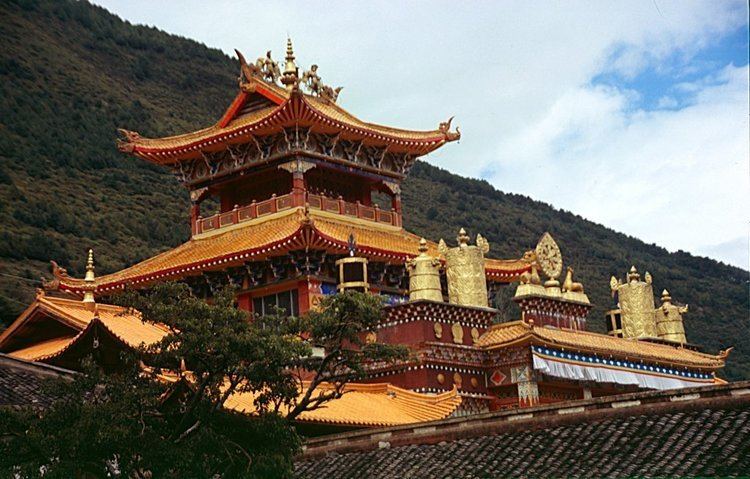Country Peoples Republic of China Elevation 2,560 m Area 11,486 km² | Population HanTibetan | |
Kangding (Chinese and English) or Dardo (Tibetan), is a city and the location of the seat of Garze Tibetan Autonomous Prefecture in western Sichuan province of Southwest China. Kangdings urban center has around 100,000 inhabitants.
Contents
- Map of Kangding
- Names
- Administrative divisions
- Description
- Climate
- Transport
- Yu yixuan love song of kangding 1949
- History
- References
Map of Kangding
Names
Kangding (Chinese: ??; pinyin: Kangding; Wade–Giles: Kang-ting) is also known officially in Tibetan as Dardo (Tibetan: ???????, Wylie: dar mdo, ZYPY: Dardo) also known as Dartsedo (Tibetan: ???????????, Wylie: dar-rtse-mdo, ZYPY: Darzedo).
Historically, the urban center was known as Tachienlu or Tatsienlu (simplified Chinese: ???; traditional Chinese: ???; pinyin: Dajianlu) from the Chinese transliteration of the Tibetan name Dartsedo until it was simplified as Lucheng (simplified Chinese: ??; traditional Chinese: ??; pinyin: Lucheng) which is the administrative seat of Kangding.
Administrative divisions
Kangding is divided into 3 towns and 18 townships:
- Lucheng ???
- Guzan ???
- Xinduqiao ????
- Yala ???
- Shiji ???
- Qianxi ???
- Shelian ???
- Maibeng ???
- Sanhe ???
- Jintang ???
- Pengta ???
- Shade ???
- Gonggashan ????
- Pusharong ????
- Jini ???
- Waze ???
- Xiaba ???
- Jiagenba ????
- Pengbuxi ????
- Tagong ???
- Kongyu ???
Description
Kangding is located in a valley of the Tibetan Plateau about 210 kilometres (130 mi) west-southwest of Chengdu, the provincial capital, and 100 kilometres (62 mi) west of Yaan. It is a city populated by significant proportions of both Tibetans and Han, and is part of the historical Tibetan region of Kham. A raging river splits the city, thus the constant sound of water reverberates throughout much of the city. The city features a sizable square where young and old alike gather in the early hours of the morning to do Tai Chi, play badminton, or socialise. This square comes alive on the weekends as well, when families tend to fill it. Traditional Tibetan and Sichuanese restaurants are easily found throughout the city. A Tibetan Buddhist monastery sits on the mountains overlooking the city, and is accessible by cable car. As of October 2006, a stone amphitheatre is under construction at the upper monastery.
It is a fast-growing city, with a rapidly developing tourist infrastructure, including a scenic cable car imported from Germany.
In 2008 the PRC government opened an airport at Kangding in the province of Sichuan, with a 4,000 metres (13,000 ft) runway, announcing that it would be the second-highest in the world, at 4,280 metres (14,040 ft) above sea level.
The folk song Kangding Qingge enjoys popularity throughout China.
Kangding contains some notable Buddhist monasteries, including Nanwu Si Monastery, Anque Monastery and Jinggang Monastery. It was from 1857 the siege of Roman Catholic Diocese of Kangding, administered by Paris Foreign Missions Society. The Catholic church was destroyed during the Cultural Revolution.
Climate
Kangding has a monsoon-influenced climate, lying in the transition between a humid continental (Dwb) and a subtropical highland climate (Cwb) on the Koppen system. Despite the elevation of 2,560 metres (8,400 ft), the diurnal temperature variation averages at most 10.5 °C (18.9 °F) in any month. From April to September, rain is a very common occurrence, with around two-thirds of the days receiving some rainfall; in addition, 77% of the annual precipitation is delivered from May to September. Monthly daily average temperatures range from ?2.2 °C (28.0 °F) in January to 15.5 °C (59.9 °F) in July; the annual mean is 7.09 °C (44.8 °F). Over the course of the year, the frost-free period lasts 177 days and there are 1,738 hours of sunshine.
Transport
Yu yixuan love song of kangding 1949
History

Kangding had been historical border between Tibet and China, from Kangding to the west lies Tibetan civilization where as to the east Chinese cultural centre. Kangding has witnessed many conflicts between Tibetan Empire and Chinese dynasties. Kangding was for many centuries an important trading city where Chinese brick tea was carried by porters from Chengdu and other centres to trade for Tibetan wool. A dispute involving the sovereignty over the city between Tibet and the Qing was resolved when the Manchu forces took the city by storm in the Battle of Dartsedo in 1701.
On July 1, 1786 an earthquake of 7.75 on the Moment magnitude scale ruined nearly the entire city.
